Tiger Colorado Townsite - Ghost town
Photos courtesy of Mike Sinnwell September 2006
The tiger says, Look close or you won't find me. As I walked around where the old town site was I discovered numerous pieces of evidence that at one time a town was here. When I first read about this town I was discouraged. This was a company built town. In 1973 the Breckenridge volunteer fire department burned it to the ground. Of course the Forest Service approved the burning of the ghost town. Why? Tiger was easily accessible to anyone and it was occupied by transients. The forest service thought it was easier to burn the whole town down than to try to keep the hippies out. Another ghost town up in smoke.
A viewer writes - Read your comments re Tiger Colorado and the transient hippies...Thanks a lot Forrest Service ..better to burn it down than have some hippies/transients etc enjoying the deserted town for free ..smokin those weeds , stinking up the place with patchouli oil ..Thank God for their genius solution ..their patriotism .. their dedication to preserving history for all of ...wait.....they did WHAT????
...They were paid for this? not arrested? go figure LES
A viewer writes April 2008 - I lived in Tiger for a short while as a child. Dad worked for the lumber mill. The owner of the company had a terrible reputation. Stores and banks wouldn't take his checks. There was no running water. A pond at the end of the road supplied water to the town. A pile of rocks was kept there to break the ice. We strained pollywogs from the water in the warm months. It is sad to find that the town was burned.
A viewer writes September 2008 - My family and I lived for awhile in Kokomo, Co back in the fifties. My dad worked for Ryan Construction, and he found a ghost town way up above Climax. It was called New Boston. Do you have any information on that town? Kokomo was an enchanting place to live. Our house was an old mining cabin, with a dugout room at the back. It had a huge door that opened into a very large room, almost like a cave. We had running water, an outhouse, and electricity and cooked on a wood stove. The school had two classrooms. Later we moved to Tiger. That town was eventually burned by the state.
A viewer writes - August 2009 - Just came across your section on the old mining town Tiger, near Breckenridge. Was interesting to see what it looks like now.......long after the Forest Service burned all the cabins to the ground in 73 to rid the land of the hippies. I was one of those hippies living there from 71 right up to the burning. Have always dreamed about returning someday to see the old place, but sure doesn't look the same. As I recall, there were about 15 or 20 of us living there on a full time basis. Sometimes more, sometimes less. It was a great time. We put a lot of work into restoring those old cabins, complete with wood/coal burning stoves for cooking and heat. We built a communal sweat lodge that was used by everyone. Although a lot of the memories are a little fuzzy from that time (wonder why), I remember a couple of bus loads of tourist driving in to see 'real hippies' living in the wild. The whole area was filled with hippies, some living in teepees, others living further up in the mountains in abandoned cabins. The meeting place for us all was the Gold Pan Bar and Grill in Breckenridge - which I understand is still there, but I'm sure with a different clientele now. We would all come down out of the hills on a Friday/Sat night and rock the place until closing. I have some photos of Tiger and some of the people who lived there if anyone is interested. Would be great to hear from anyone else who was there during that time. I can be reached at surf.zen@verizon.net. Peace to all. David
A viewer writes (and Contributes Photos ) September 2009 - Hi there, Sorry it took so long to get back to you. Locating these photos was a little more difficult than I thought. I know there are a few more - somewhere. I'll keep looking. Most of these were taken in our early, moving in stage. I had another role of film of some really great shots of Tiger not too long before the burning - including interior shots. By that time, most of the cabins were in good living shape. Alas, that role of film was lost after being run out.
Here's a short bit of what we did.
We covered our windows with clear plastic tarp. Our doors were salvaged from various dumps and then cut to size. I was the proud owner of the only 'refrigerator' in Tiger. Actually, what I had done was attach an old refrigerator door to the inside of one of my kitchen window frames. The outside of the window frame was covered with thick plastic sheeting with holes punched in it to let in the cold air/snow. Shelves were attached to the inside of the window frame to hold things. Worked amazing well.
Most of the cabins were heated with coal, using old Baseburner Stoves we found here and there. In addition, I was fortunate enough to have a beautiful 4 burner, wood burning oven. I found it buried under a coal dump several miles away and dragged it back in a few large pieces and reassembled it. As far as I know, those stoves were burned with the cabins. Too bad, they were the real deal. The photos are examples of what we used.

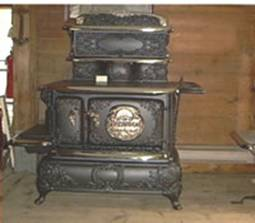
Stove for heating.jpgKitchen Stove.jpg
During the spring and summer we gathered wild flowers and herbs and dried them by hanging them from the rafters inside the cabins. Always smelled great inside.
We weren't officially a 'commune'. Just a bunch of us who wound up there for awhile. But we still used a couple of the cabins for communal meals now and then. People came and went.
Thanks for your interest. I'll send more when / if I find them.
David Matis
The Photos --- Courtesy of David

#1. This is the road leading in to Tiger. As I recall, there were 5 or 6 cabins. Mine was the second one on the right. Numerous other cabins were scattered all over those mountains. Have no idea how many hippies were living in them thar hills during that time, but there were a lot of us. Many lived in teepees.
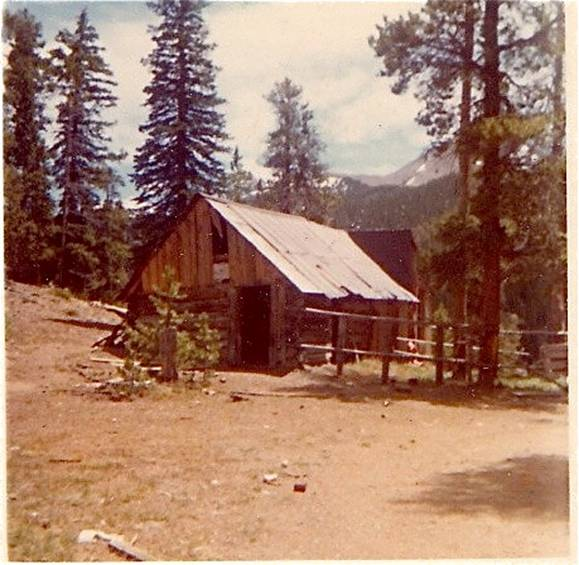
#2. This is a cabin located about 5/10 min from Tiger. As I recall, it was a pretty good hike up the mountain to get to it. Rumor had it that this cabin was part of a string of cabins scattered around the area used as a sort of 'pony express' sort of thing. But no one actually confirmed that.

#3. Wild burros ran loose in the mountains. Every now and then, one would wander into Tiger for some attention.


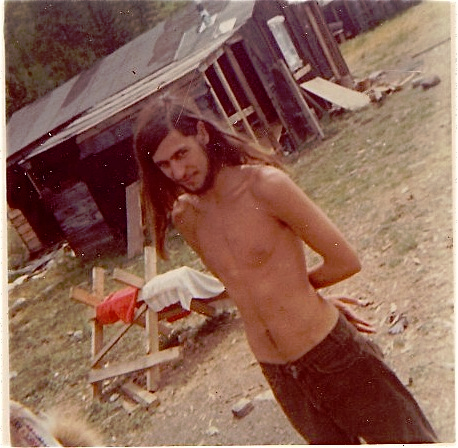
That tall, slim man without a shirt, and long hair -- is Harvey -- a man I lived with at Tiger Town in the winter/spring of 1972. So good to see him again, and to see these images of a place I've loved and apparently have lost.
Thanks so much for posting!
Mary Grogan
fullcirclelifedesign.com
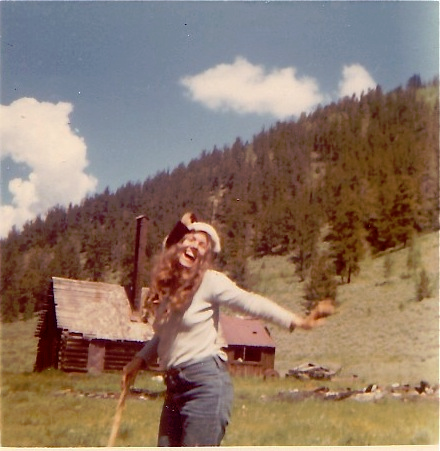
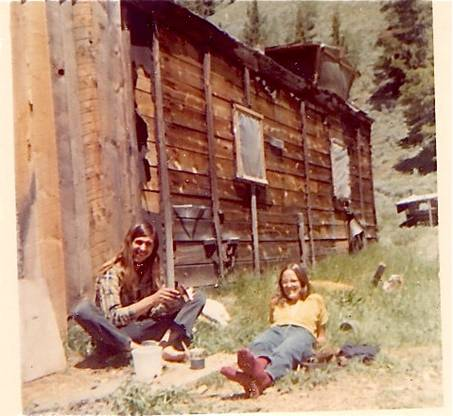
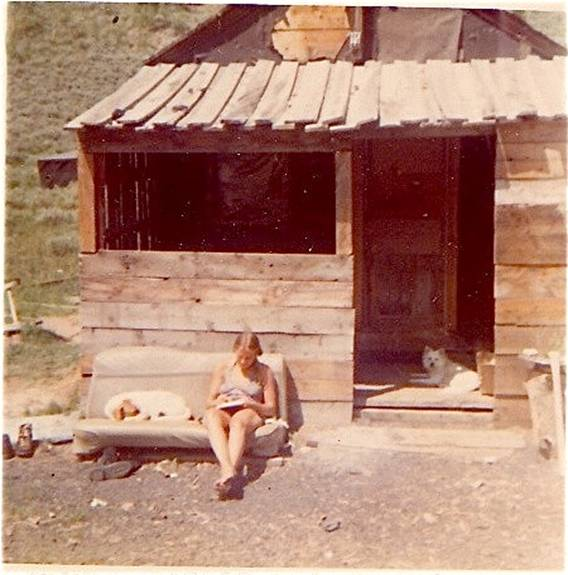

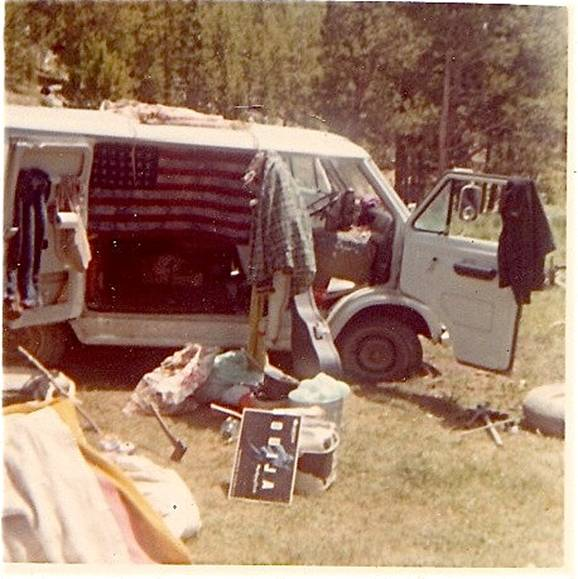
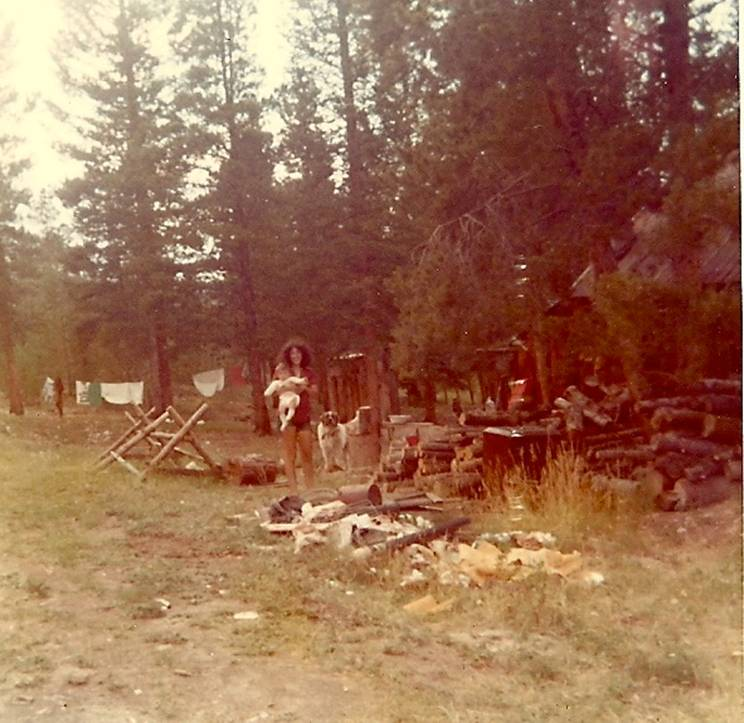

Photos:# 4 - 5 - 6 - 7 - 8 - 9 - 10 - various shots around Tiger.
#11. A shot of my van. I had been living in it while traveling the country. Continued to live in it while fixing up the cabin.
#12. One of the hippie moms with baby in front of her cabin. I have at least one more close up of her - somewhere.
#13. Heating the stones for one of our communal sweat lodges.
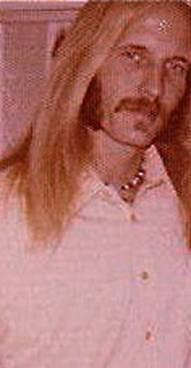
#14. A picture of me - believe it or not, AFTER a hair cut and shave. Taken about 8 months after being burned out. I had left for California after that.
A viewer writes November 2009 - I just happened on to this site by chance, it brought back some fun memories. I lived in Tiger in the summer of 1968, I was 12 or 13 at the time, no one else lived there except my mom, younger brother and my youngest sister. It was fun except when the grizzlies would come around at night foraging for food! We lived in the second house on the right when you first come into Tiger. LOL what a fun summer! Del Ballweber
A viewer writes - Monday March 7th 2011 -- I am doing some family genealogy and was researching Tiger Colorado where my grandfather Rueben Joel Moffett was born. His father Henry Clay Moffett along with his brother George Moffett came out from St. Joe MO, Buchannan cnty around 1890 according to my calculations, my great grandfather was born in Tiger September 7, 1899. His older sister was born in 1892 in Tiger.
Continued with more info on Tiger - Hi Mike, Thanks for getting back to me. By all means you have my permission to repost my comments. Minus my phone number please.
I grew up in the mining communities of Leadville until the collapse of the Climax operation in 1969, I was about 10 at that time before we moved to Denver with the flat landers. Tiger and it's historical history has been a constant search for my family and myself. Royal Tiger bought up other mining operations and ran a company town there close to Breckenridge (Another fine Scottish name). My great great grandfather had brought his family to Colorado looking for gold and opportunity. His son, my grandfather lost his life at the Climax mine when hit by a mining training coming out of the Phillipson Tunnel. Dragged himself to the steps of the hospital which I understand was less than a football field from the Phillipson Tunnel. Died a couple weeks later of complications. I became grand fatherless when my father was 8 years old.
I noticed you do not list Kokomo on your list of ghost towns. It was a small town NW of Climax that was eventually abandoned due to the expansion of tailing ponds. The town of Climax should also be listed as a Ghost Town, because there was actually a company town across from the mining operation. The mining operation supplied houses etc for miners. These homes were moved to West Park (Leadville). Climax had apartments, bowling alley, trading post and a bar named the Slop Chute. The apartments buildings and homes were picked up on jacks and lowboys then moved down to West Park (Leadville) where they still stand today. The north part of Leadville expanded when they started bringing homes down the hill in 1960. The bowling Alley, hotel, movie theater, Safeway and other business all were built at the same time to service the newly created West Park.
The Company Town idea started at the turn of the century to keep miners happy. Royal Tiger of Tiger Colorado supplied the homes and paid electricity. Climax kept miners in debt by offering limitless credit and "Chits" they could buy on credit to use in the Slop Chut Bar, or at the bowling alley and even a theater. Most miners were so in debt to the company that there checks were used to pay off the credit extended. Climax was the first town to have television in Central Colorado. Mining crews climbed to the top of Mount Barlett built a trolley tram to build a repeater atop the mountain with it's own power. People from surrounding communities as far as Salida would come to see television there. Leadville was a rootin tootin crazy town where miners were recruited from every part of the USA came to work. Checkers was the big game in town, and the Golden Burro was lost and changed ownership in a checker game. The Military during the war even sent criminals, deserters and misfits to work the Moly Mine because it was so important to our defense.
To think that in 1879 while everyone else was hunting gold, a prospector named Senter found the first molybdenite, funny but it took around 20 more years before anyone else could figure how to use it. It surpassed gold and silver as a money maker in Colorado. By the middle of the depression Climax mine stock prices were the highest on the stock market at around $41 per share. The ghost town history of CLIMAX is definately note worthy. Those who visit Colorado probably don't catch that most of the ghost towns were company mining towns.
Thanks for the great website! Glad I stumbled across it and I will book mark this and share.
Brian Moffett aka Moose
A viewer writes - Friday, November 02, 2012 - As a young teenager, I lived in Tiger, Colorado twice when my father accepted employment from Henry Jarvis, the owner of the saw mill located in Tiger. All total, I spent about three years exploring the surrounding landscape, catching fish with my hands in the summer when water levels receded among tailing of the mining dredge that had turned over the river bottom. I have many fond memories of a simpler life that was full of mystery and adventure. I attended school in Breckenridge, Colorado. We lived in the hand-hued log cabins that had been slightly renovated. I remember hauling water by hand from a pond that was located at one end of the community. The woods crew that cut and skid logs doubled as the mill crew during the winter and when an order for rough lumber was needed to be cut. The only running water that we had came from the river and a 2 1/2 horse Briggs and Straten gas driven pump and garden hose that we buried deep underground between the river and our cabin. Our cabin was two stories and we had five wood stoves. A cook stove in the kitchen, an on the back covered porch for heating wash and bath water. We also had three pot belly stoves, one in the food pantry room that we kept lit throughout the winter to keep our canned good from freezing and a second pot-belly in the living room and a third in my parents bedroom. I slept in the kitchen during the winter and upstairs in my own bedroom in the spring summer and fall. I hunted for and collected antique bottles by the dozens and used some for target practice until I learned they were worth money. I sold my collection of 180 bottles to an antique dealer in Leadville, CO. I ran a trap line behind the saw mill as wildlife was fairly abundant. I discovered several sub-communities in the surrounding area within a day's walk of the logging camp. I would be interested in talking with anyone who lived in Tiger from 1958 to 1962. I can be reached at danap18@comcast.net . I was saddened to learn that the local government torch Tiger which was such a wonderful and rich historical treasure that should have been preserved. I have only a few black and white photos. Posted: Nov 2, 2012 by B. STEC
A viewer writes - Monday February 18th 2013 -- Hi, I am looking for more information on a commune called Tiger on the Swan. Is this the same thing? My mother stayed there in early 1971 I believe. She posted a picture on Facebook (Tiger on the Swan profile name) of the place she stayed. I am wondering if you could help me out at all? Any information would be GREATLY appreciated!
Rocky Responds - Yes the Tiger Ghost town on my web site is one and the same.
A viewer writes - Wednesday, February 20, 2013 -- I am looking for people who stayed at the Tiger anywhere from 1970 (late) to March of 1973. My mom went by Isa and worked at the Goldpan. She said she lived in one of the cabins way down at the end. I guess they all called it the Tiger on the Swan commune! Looking at the pictures was great, and if anybody else has any info please e-mail! jessicacrim@hawaiiantel.net Thanks!
A viewer writes - Saturday, January 25, 2014 -- I lived at Storyland above Tiger on the north fork of the Swan from 1972 to 1975. Good times.
Rocky Says - Never heard of Storyland. Of course there is a lot I don't know. Maybe there really was a Storyland, it was the 70's.
A viewer writes - Friday, May 23, 2014 - Yes, Virginia. There IS a Storytown (past Tiger - up the road till you can't drive anymore - to the bridge and stream. Then hike up to the left along the rutted road and VOILA! Semore Storyland is on the left.) My college friend, Cathy, lived there w/a bunch of people around 1971-73. My friend, Karen, sister Jacque, hubby Steve and I first visited her in '72. We visited her several more times and continued to camp in the area for years till the early 90's. It's what made us all move to COLORADO in '73! Sadly, "they" burned down that cabin, too. I cried. I have pics. Will lOOk for them. Jill jillzo@comcast.net
A viewer writes - Saturday, November 01, 2014 5:51 PM
I am a mining historian at Breckenridge, Colorado. I have been investigating mining sites, ghost towns and the like around Breckenridge since 1989. I conduct some tours and hold Powerpoint presentations on Breckenridge history in the summers in Breckenridge and nearby Frisco. I was awarded the Theobald Award this past summer by the Breckenridge Heritage Alliance for my contribution to the preservation of Breckenridge's history.
I was just given your web site and found the stories fascinating on the Town of Tiger. I have co-authored three books on Breckenridge mining history in the past three years. Currently we are working on a book on Swandyke, Colorado, another ghost town that was inhabited by hippies in the 1970s.
Our next book will be on the history of the Royal Tiger Mines Company and the company that followed it, the B&B Mines Company. I have all the minutes from the B&B Mines Company Board of Director's meetings from the 1940s to about 2008 when it was dissolved. It includes a lot of information on the Town of Tiger.
I would like to collect as much information as I can from people that lived in the Town of Tiger or have stories about it. I plan to use some of these in our book on the Royal Tiger Mines Company.
I would also like to get as many photos similar to the ones you have posted on your web site of Tiger. I currently have over 100 photos of the Town of Tiger and the Royal Tiger mine and mill. I would be willing to share some of those to be posted to your web site.
I would also like any photos your readers have of Swandyke, Breckenridge, Preston, or any other photos of the Breckenridge area including any of the mines from say the 1980s and before.
You could list my email address (bigobill@aol.com), be sure any email to me has "Town of Tiger" or something I will recognize as I do not open any email I don't recognize.
Bill Fountain
Jayci (Williams) Cosens provides this information on Tiger. September 2015
Good morning! I have been doing some research on Tiger, Colorado and came across your page. My great-grandparents, Perry and Alice Williams along with my grandfather, Jack Williams (born in July of '29), lived in Tiger in 1929-30. My great-grandfather, Perry Williams, was the night watchman at the mine. Armed men came in one night, they used a rope and tied his arms behind his back and tied him to a chair. While the robbery was going on, he was able to free his arms from the chair and he ran from the mine (arms still tied behind his back). The robbers chased him out of the mine, as he was escaping, they were firing their pistols at him, but he was not hit. That was his last night ever working in the mine and the family returned to Southeast Kansas shortly after this and spent the rest of their lives there.
My great-grandfather died in 1989 when I was only 10, so I guess my youth and the passing years changed it! This is the story as my dad told to me. He had to correct me. I thought the robbers had thrown my Great grandfather down a mine shaft.
I am attaching a picture. The back, in my great-grandmother's handwriting says: "His wagon and sunbonnet. Jack W. and Perry W. Tiger, Colorado, 1930".

Thank you! Jayci (Williams) Cosens
A viewer writes April 22nd 2018 - In 1968 I traveled around the USA for the whole summer. I remember leaving Kremmling and heading for Tiger when I was told that it was abandoned.
It was about 8 miles in on a dirt road. On the right side as I entered the town, was the old mine head. Past the mine head, on the right, were a few abandoned houses. The walls were half planked and as I explored them, I found a lot of open bills, old shoes and other stuff left behind.
Past them, on the right, was a saw mill and a repair shop for trucks. There were a lot of truck parts still there. Between the road and these buildings there was a deep drainage ditch. On the left side of the road were the older buildings. The very first one had old wall paper crumbling off the walls and the rear of the building had a bakery attached to it.
I peeled off some late Victorian wallpaper and underneath was part of the New York Police Gazette from 1885. I could read the article about some Colorado Cuss who was shot by his wife when she found out he had another family somewhere.
The town was completely abandoned when I was there, but still mostly intact. It felt a little spooky but it was a bright sunny and peaceful day. It was years later that I learned it had been burned down because of the "Hippies". What a loss, but fond memories for me.
Fredrick J. Spector
| Alaska |
| Arizona |
| California |
| Colorado |
| Kansas |
| Missiouri |
| Montana |
| Nevada |
| New Mexico |
| North Dakota |
| Utah |
| Wyoming |
| Yukon |
| Viewer Contributions |
| Chicken |
| Chitina |
| Dyea |
| Eagle |
| Fort Egbert |
| Hope |
| Independence Mine |
| Kennicott Kennecott |
| McCarthy |
| Nome |
| Rika's Roadhouse |
| Skagway |
| Sunrise City |
| Valdez |
| Alaska Scenes |
| Alaskan Adventures |
| Exit Glacier |
| Ganes Creek |
| Gold Dredge Number 8 Fairbanks |
| Ninilchik's Russian Orthodox Church |
| Portage Glacier |
| Andy Hehnlin |
| Bodie |
| Colorado Ghost Towns |
| Scenes |
| Adena Thru Dearfield |
| Derry Ranch thru Hull City |
| Idaho Springs thru Orchard |
| Oro City thru Summerville |
| Summit thru Yampa |
| Bonnies Bonanza Memories |
| Dredge near Fairplay |
| Hugo Helps A stranger |
| Jane Kirkham Grave |
| teller city 2019 |
| Buildings - Sights - vistas |
| Mines and Mills |
| Passes |
| Tombstones |
| California |
| Cinnamon |
| Engineer |
| Georgia |
| Hoosier |
| Hurricane |
| Keebler |
| Loveland |
| Monarch |
| Mosquito |
| Rollins Corona |
| Fort Larned |
| Fort Scott |
| Neosho Falls |
| Round Barn |
| Watkins Mill |
| Bannack |
| Garnet |
| Granite |
| Nevada City |
| Virginia City |
| Austin |
| Belmont |
| Belmont Mill |
| Berlin |
| Cliente |
| Caselton |
| Cherry Creek |
| Eureka |
| Hamilton |
| Humbolt |
| Ione |
| Lower Rochester |
| Manhattan |
| Pioche |
| Rochester |
| Sandy Springs |
| Thunder Mountain |
| Unionville |
| Fort Abercrombie |
| Fort Buford |
| Fort Union |
| Arches National Park |
| Bluff |
| Frisco |
| Sego |
| Zion NP |
| Atlantic City |
| Devils Tower |
| Fort Laramine |
| Independence Rock |
| Medicine Wheel |
| Miners Delight |
| Savery WY - Little Snake River Museum |
| Sherman |
| South Pass City |
| Carcross |
| Dawson City |
| Montaque Roadhouse |
| Trail to the Klondike Gold Fields |